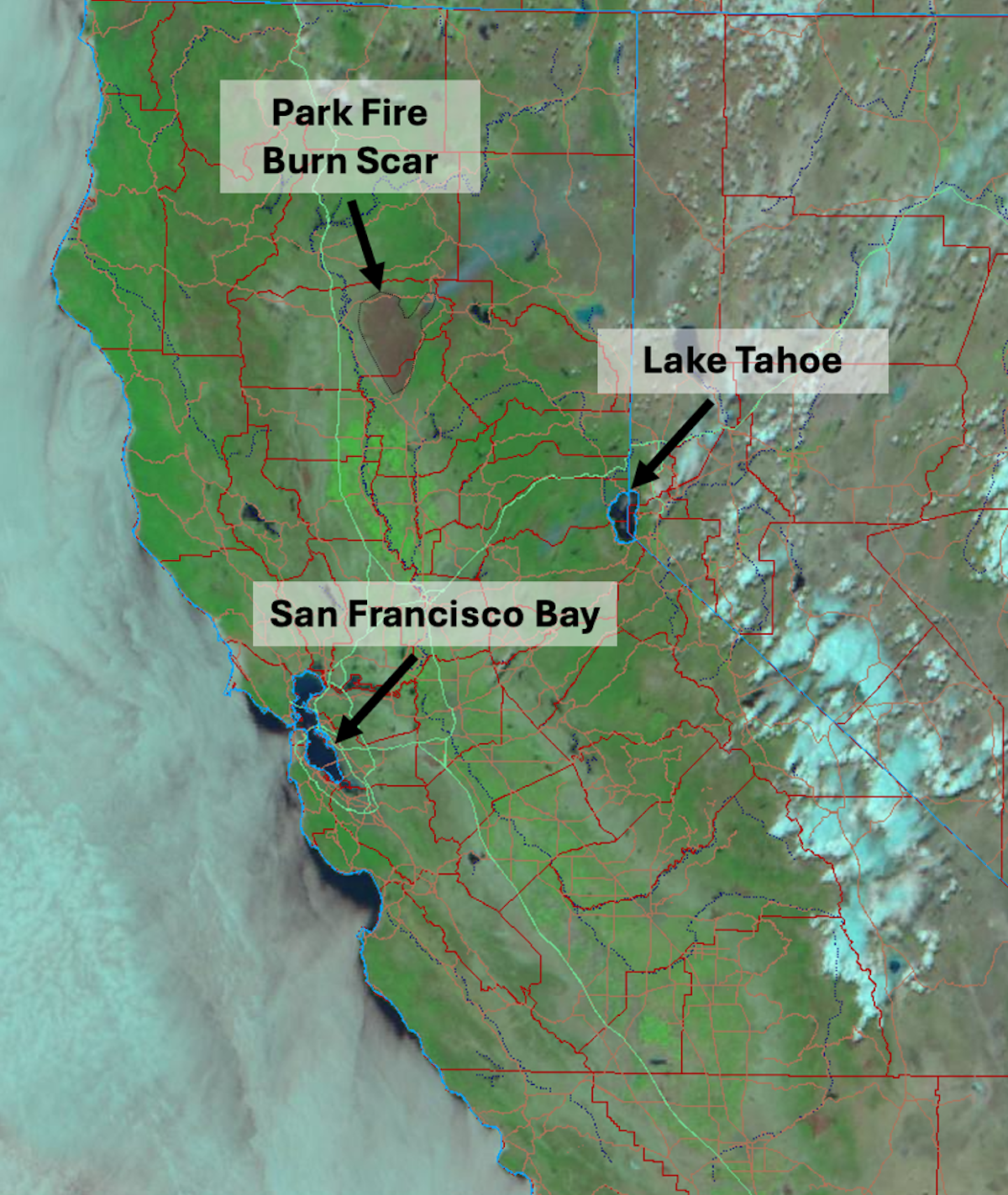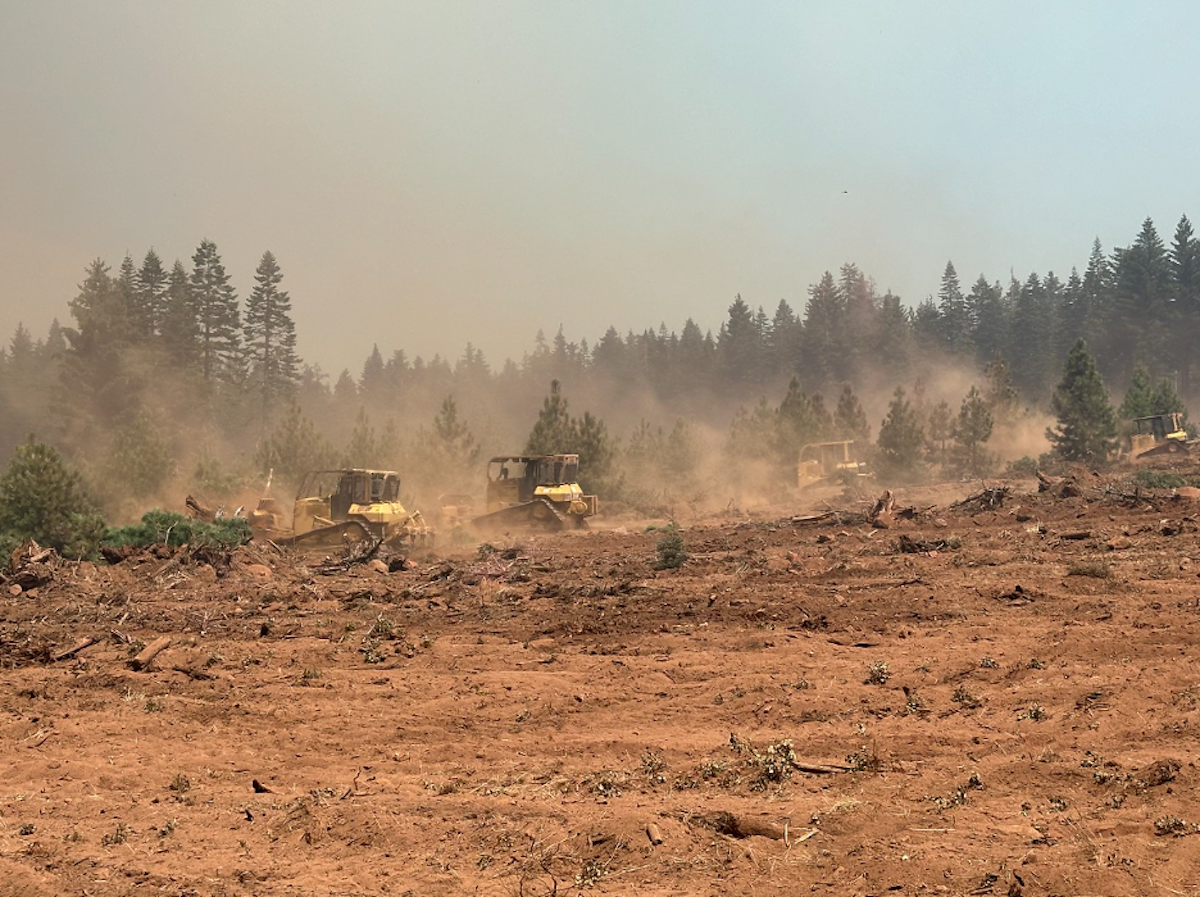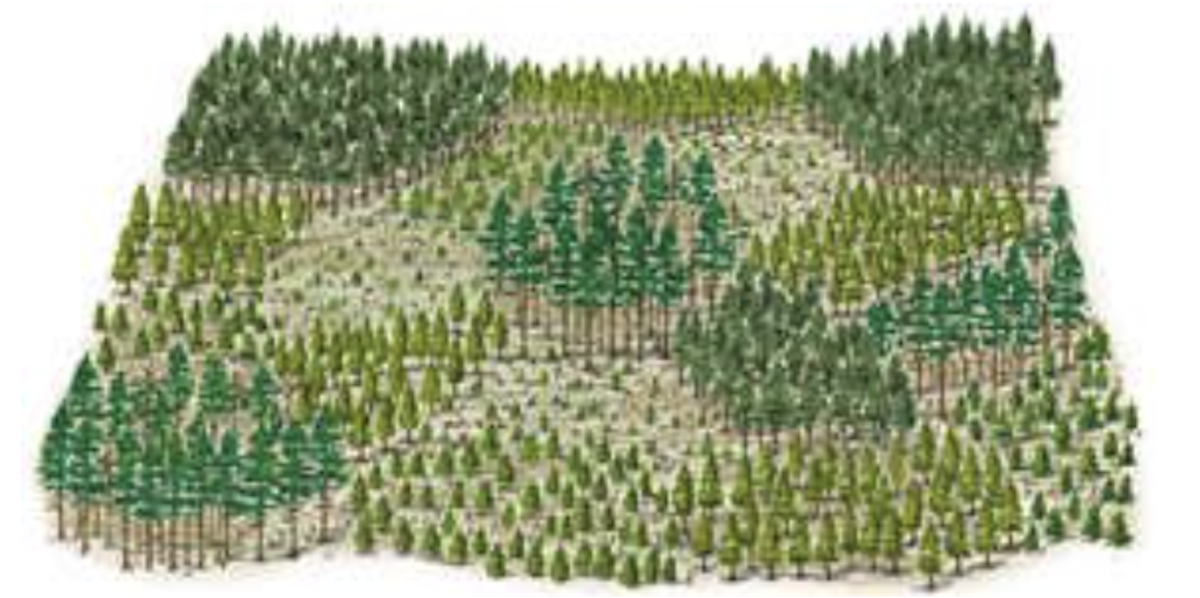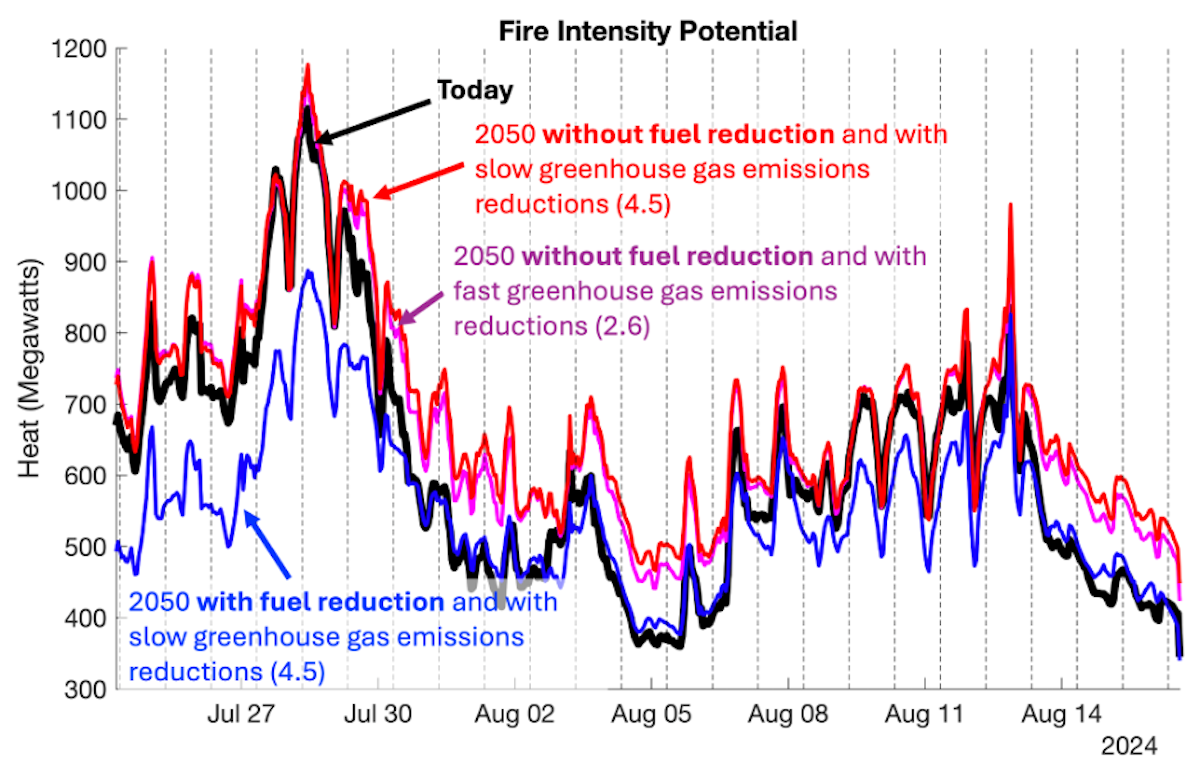California’s Massive Park Fire Would be Less Severe if We Proactively Reduced Fuels
The Park Fire Shows That Both a Lack of Active Management on U.S. Forest Service Land and Land Management Optimized for Timber Production are Far from Ideal for Wildfire Safety.
-
-
Share
-
Share via Twitter -
Share via Facebook -
Share via Email
-
Wildfire season is ramping up across the United States, and nowhere is that more apparent than in northern California, where the Park Fire has been burning since July 24th. As of today, August 14th, the Park Fire has burned nearly 430,000 acres (672 square miles), or about 65% of the size of the state of Rhode Island. It is still only 39% contained and has destroyed over 600 structures.

The Park Fire currently stands as California’s fourth-largest fire since meticulous record-keeping began in the 1980s, and by itself, it has burned more area than that from all California fires in the calendar years of either 2022 or 2023.

Throughout its lifetime, it has exhibited extreme fire behavior, like giant rotating plumes of smoke, and its severity will undoubtedly be catastrophic, with widespread tree mortality in many of the forests it has burned.
Large catastrophic wildfires like the Park Fire are now typically covered through the lens of climate change as this tends to be the most salient angle for consumers of the news. This is the same reason why researchers themselves are incentivized to frame their wildfire-related research questions in a way that centers climate change. But wildfire outcomes are the result of many factors, including how we manage the landscape. Our research, discussed below, indicates that land management choices have more leverage on wildfires like the Park Fire than climate policy does over the next several decades.
Climate Change is Just One of Many Drivers of Wildfire Behavior
Climate change is just one element of many that affect wildfire behavior and outcomes, and focusing exclusively on it distracts from practical solutions to increasing wildfire danger.
First, fires need to be ignited, and 84% of wildfires in the U.S. are started by people. The Park Fire was apparently deliberately started by a man who pushed a burning car into a ravine. Once started, wildfire behavior is well known to result from environmental influences that can be divided into the categories of topography, weather, and fuels (i.e., the live and dead vegetation that fires burn).

The Wildfire Behavior Triangle describes the three main categorical drivers of wildfire behavior.
Humans have little effect on topography, but can affect the weather by emitting greenhouse gasses and warming the global climate. Summers in the region where the Park Fire is currently burning have warmed at about 0.8°F per decade since 1975, and according to climate models, we expect them to warm about 1.5°F between now and mid-century. This warming decreases the moisture in fuels, causing fires to burn more intensely and spread faster.
The other major way humans influence wildfire behavior is through our influence on the vegetation that fuels fires. First, we fight wildfires primarily by interrupting their fuel source.
We use bulldozers and heavy equipment, combined with setting intentional fires, to “contain” fires by breaking up the continuity of their fuel. The Park Fire, for example, has had hundreds of bulldozers and many thousands of personnel deployed, creating these lines to contain the fire.


This way of breaking up the fuel continuity in an effort to fight an active fire might be considered reactive fuel reduction, but we can also proactively manage the landscape to reduce fuels.
The Park Fire is currently burning in forests at two ends of the extreme of the degree of human intervention on the landscape, and neither is ideal for reducing wildfire danger. One end of the extreme is essentially the lack of active management on the US Forest Service land in Lassen National Forest, and the other is management optimized for timber harvests on the private land owned by Sierra Pacific Industries (SPI).

Forests Managed for Timber Production Exacerbate Wildfire Danger
The forests managed for intensive timber production in the Sierra Pacific Industries (SPI) territory are marked by the ~20-acre patches of clear-cut areas. These “group selection” patches are meant to promote the natural regeneration of trees from nearby mature live trees while maintaining habitat for various species and reducing the aesthetic issues associated with clearcutting larger swaths.

On the one hand, these patches do allow for firefighters and flame retardants to have good access to an active firefront. However, open patches also tend to allow more sun and wind at the surface, which can facilitate faster fire spread, especially if dry brush is allowed to build up. Additionally, relatively tightly packed, younger tree stands (designed to maximize revenue from timber) are particularly sensitive to high-severity catastrophic fires. While SPI has engaged in some thinning practices and put in strategic fuel breaks designed for wildfire mitigation, this is not the same as managing forests specifically to reduce the risk of catastrophic fires where, e.g., only smaller trees less than 2 feet in diameter are removed.
Unmanaged Forests Exacerbate Wildfire Danger
On the other end of the spectrum is the non-management exemplified by the portion of the Park Fire burning within the boundaries of the Lassen National Forest. Here, we see the manifestation of ill-advised policies starting in the early 20th century that sought to exclude all fires from the landscape. These policies have led to a large build-up of tree and vegetation density in much of America’s forests.

This exacerbates wildfire danger for several reasons. Densely packed vegetation means increased competition for finite resources (like water, sunlight, and nutrients) that make ecosystems more susceptible to disease and sensitive to drought, which increases their proclivity to burn. It also makes fires more likely to climb into the canopies of forests, where they can kill the entire forest.
The image below shows the consequences of this. In the 1800s, frequent fires sustained open Ponderosa Pine forests northwest of Colorado Springs, but a century of fire exclusion produced dense forests by the year 2000 that were devastated by the Hayman Fire in 2002. The forest has yet to recover.

More vegetation also means fires burn more intensely, produce more smoke, a huge detriment to human health, and create more ash, which harms municipal water supplies. Finally, a densely packed forest makes it more difficult for firefighters and fire retardants to access fires.
This legacy of fire exclusion is affecting the Park Fire, whose active northeastern flank has been burning in a region that has not experienced a fire in about a century. This is a similar setting to that of the devastating Dixie Fire of 2021, which burned nearly 1 million acres, caused over a billion dollars in damage, and resulted in widespread tree mortality.

Specifically, the active northeastern edge of the Park Fire, which is the main area of concern for further growth (pink arrow), is in a region with very high tree density and, thus, very high amounts of fuel available for the fire.

This tightly-packed forest with ample fuels was identified by the California Wildfire Taskforce several years ago as having significant wildfire hazard potential and being prone to high-severity fires that will kill most of the trees.

Rather than hastily removing fuels under critical fire-weather conditions to contain an active blaze, these fuels can be removed proactively with mechanical thinning (using machines to remove vegetation) and prescribed burning (intentionally setting fire to the landscape under much more mild conditions when the fire can be controlled).

The idea is that mechanical thinning to remove trees with smaller diameters and prescribed burning to remove live and dead surface vegetation will reduce fire intensity, produce less smoke, and be less likely to kill mature trees. Some wood products can be sold from mechanical thinning to offset the cost of conducting these treatments, but this is quite different from the aforementioned “group selection” land management specifically for timber harvesting.

The above diagram represents the theory for why this type of fuel reduction should work, but there is also ample empirical evidence that it works in practice. This is exemplified by meta-analyses of dozens of studies, but a picture says 1,000 words. Below is a photo of the after-effects of the Bootleg Fire in Oregon, which happened to traverse an area that had no fuel reduction, an area that had recently undergone only mechanical thinning, and an area that had recently undergone both mechanical thinning and prescribed burning.

The effects on severity were stark. Without fuel treatment, the fire killed the vast majority of mature trees, devastating the forest. The forest came out in better shape in the area that experienced only mechanical thinning, but the most benefit was seen where both mechanical thinning and prescribed burning occurred.
We see this same effect currently in the firefighting operations on the Park Fire, where areas of minimized surface vegetation and large, widely-spaced trees are experiencing only low severity fire.
How Much Would Fuel Reduction Reduce the Intensity of the Park Fire?
The above constitutes evidence that fuel reduction makes a difference, but how much of a difference does it make, and how does this compare to the other effect that gets the most attention—climate change? We are conducting original research that seeks to answer these questions.
We use machine learning to untangle the complex relationships between the weather, topographic, and fuel variables and the resulting fire intensity using over 27,000 satellite observations of fires. Once the relationships are quantified, we can predict fire intensity for any conditions, like, say, over the next couple of days across the entire state of California. We can also take conditions over the course of a fire and warm the background climate to see what we expect fire intensities to look like in the future and/or simulate fuel reduction treatments to see how future warming and fuel treatments would simultaneously affect a fire over its lifetime.
Below, this procedure is applied to the Park Fire. The black line shows the calculated potential for fire intensity over the Park Fire's lifetime (using a weather forecast for a few days in the future). We see tremendous variability driven by changes in weather, topography, and underlying fuels over the course of the fire.

In particular, we see daily peaks in fire intensity as it gets warmer and drier in the afternoon, especially when this coincides with strong winds. Also, the amount of fuel and how dry that fuel is are huge drivers of fire intensity potential.

In addition to the black line, which represents the severity of the Park Fire under today’s climate and fuel conditions, the colored lines represent the same Park Fire progression in 2050 temperature conditions, with and without hazardous fuel reduction (fuel reduction is represented using 10 characteristics shown in Extended Data Table 2, here).
In 2050, the temperature conditions will be about 1.5°F warmer, which translates into drier fuels more conducive for higher-intensity fires. The red and magenta lines show the situation without hazardous fuel reduction. We see that the red and magenta Fire Intensity Potential lines are almost universally higher than the black Fire Intensity Potential line, indicating that the warming in the 2050s does increase fire intensity. Sometimes this climate change component is quite large. For example, on August 5th, this increase was about 25% from around 400 megawatts to around 500 megawatts. However, hourly and daily weather variability is much larger than this climate change signal.
It is important to note that two different greenhouse gas emissions scenarios are shown. One is a slow emissions reduction scenario that roughly represents current global policies (SSP2-4.5), and one represents fast emissions reductions that are much more aligned with the Paris Agreement (SSP1-2.6). The movement from the slow emissions reduction scenario to the Paris Agreement scenario represents major differences in the global energy and agricultural economies, technology adoption, geopolitics, etc. Yet, these differences translate into only marginal changes in Park Fire’s 2050 intensity.
When it comes to addressing the wildfire crisis, greenhouse gas emissions reductions are often heralded as the primary lever we can pull. However, trying to influence weather-related outcomes through energy policy is incredibly indirect and there are often much more direct solutions at hand.
In that vein, the blue line represents the progression of the Park Fire in 2050 under slow emissions reductions (4.5) but with hazardous fuel reduction. Not only is the blue line always below the red and magenta lines, meaning that it would reduce fire intensity over the fire's entire lifetime, but it is also typically below the black line representing the Park Fire in today’s climate.
This means that even in a situation of 2050 warmth, under a slow emissions reduction scenario, hazardous fuel reduction would reduce the Park Fire’s intensity relative to today.
We Need Reform to Scale up Hazardous Fuel Reduction Treatments.
The above is specific to the Park Fire but we find that these results are generally representative for the state of California as a whole over a range of conditions. We also calculate that these types of fuel reductions, though expensive, are nonetheless very likely to induce a net economic benefit.
This is evidence that California’s goal to increase hazardous fuels reduction treatments to 1 million acres per year, along with the federal government’s target of reducing fuels on 50 million acres over a decade, are laudable and would be helpful in combating the growing wildfire threat.
However, actually achieving these goals requires overcoming multiple challenges, including funding constraints, workforce shortages, and logistical issues related to complex land ownership patterns.
Finally, there are bureaucratic and regulatory obstacles associated with the California Environmental Quality Act (CEQA) on California state land and the National Environmental Policy Act (NEPA) on federal land. The NEPA process, in particular, is associated with significant obstacles to fuel reduction treatments. The Forest Service writes the most NEPA reviews of any federal agency and is the most likely to be sued, resulting in litigation that delays project implication by about 3 years on average.
The recently adopted California Vegetation Treatment Program (CalVTP) is designed to reduce the time and resources needed for individual project alignment with CEQA, and there is momentum for reform of NEPA to increase the pace and scale of hazardous fuels reduction treatments on federal land.
These reforms offer some promise, but as it stands, actually achieving the articulated acreage targets for fuel reduction will continue to face significant funding, coordination, political, and legal hurdles. All efforts should be made to overcome these barriers because the evidence shows that hazardous fuel reduction would have reduced the intensity of the Park Fire and wildfires more generally. Further, we show that we could have a future of reduced wildfire danger despite the inevitable warming that is in the pipeline and regardless of the specifics of global climate policy. Ultimately, achieving this future involves shifting away from land management schemes that couple fire exclusion with a hands-off approach or those that seek to maximize timber production and towards management plans that are explicitly designed to optimize forest health and wildfire resilience.

